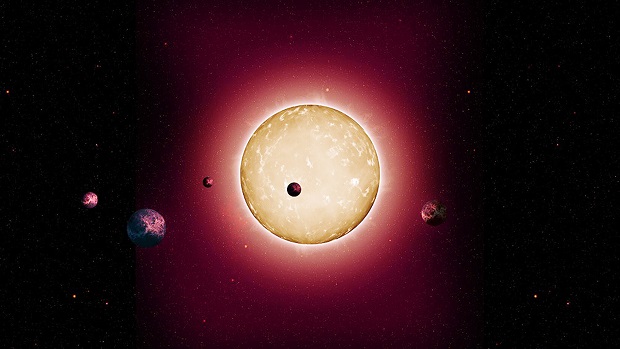Search for alien signals expands to 20,000 star systems

This artist’s rendering made available by Tiago Campante and Peter Devine shows the Kepler-444 star system, surrounded by at least five earth-sized planets. On Tuesday, Jan. 27, 2015, an international team of astronomers announced that this extrasolar system is 11.2 billion years old. With the age of the universe pegged at 13.8 billion years, this is the oldest star with close-to-Earth-size planets ever found. AP
MIAMI, United States — The search for radio signals from alien worlds is expanding to 20,000 star systems that were previously considered poor targets for intelligent extraterrestrial life, US researchers said Wednesday.
New scientific data has led the SETI Institute to believe systems orbiting red dwarfs — dim, long-lived stars that are on average billions of years older than our sun — are worth investigating.
READ: Exploding star caught by NASA’s Kepler space telescope | Scientists spot brightest supernova yet, outshines Milky Way
“This may be one instance in which older is better,” said astronomer Seth Shostak of California-based SETI, a private, non-profit organization which stands for Search for Extraterrestrial Intelligence.
“Older solar systems have had more time to produce intelligent species.”
The two-year project involves picking from a list of about 70,000 red dwarfs and scanning 20,000 of the nearest ones, along with the cosmic bodies that circle them.
To do this, scientists will use the SETI Institute’s Allen Telescope Array in northern California, a group of 42 antennas that can observe three stars simultaneously.
“We’ll scrutinize targeted systems over several frequency bands between 1 and 10 GHz,” said SETI scientist Gerry Harp.
“Roughly half of those bands will be at so-called ‘magic frequencies’ — places on the radio dial that are directly related to basic mathematical constants,” he added.
“It’s reasonable to speculate that extraterrestrials trying to attract attention might generate signals at such special frequencies.”
For a long time, scientists ruled out searching around red dwarfs because habitable zones around the stars are small.
Any planets orbiting them would be so close that one side would be constantly facing the star, making one side of the planet very hot and the other quite cold and dark.
But more recently, scientists have learned that heat could be transported from the light side of the planet to the darker side, and that much of the surface could be amenable to life.
“In addition, exoplanet data have suggested that somewhere between one sixth and one half of red dwarf stars have planets in their habitable zones, a percentage comparable to, and possibly greater than, for Sun-like stars,” said the statement.
Experts have been hunting for alien intelligence for six decades, but have not found any evidence yet.